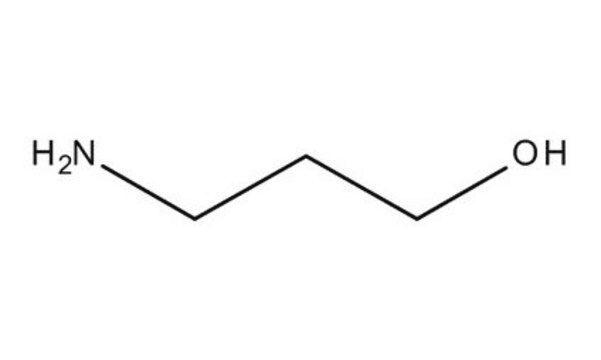8.00894
N-Ethyldiisopropylamine
for synthesis
Sinonimo/i:
N-Ethyldiisopropylamine, N,N-Diisopropylethylamine
About This Item
Prodotti consigliati
Tensione di vapore
14 hPa ( 20 °C)
Livello qualitativo
Saggio
≥98% (GC)
Forma fisica
liquid
Temp. autoaccensione
240 °C
Potenza
200-500 mg/kg LD50, oral (Rat)
Limite di esplosione
0.7-6.3 % (v/v)
pH
12.3 (20 °C in H2O, as an emulsion)
kinematic viscosity
0.88 cSt(20 °C)
P. eboll.
127 °C/1013 hPa
Temp. transizione
flash point 9.5 °C
Densità
0.76 g/cm3 at 20 °C
Temperatura di conservazione
2-30°C
InChI
1S/C8H19N/c1-6-9(7(2)3)8(4)5/h7-8H,6H2,1-5H3
JGFZNNIVVJXRND-UHFFFAOYSA-N
Descrizione generale
Applicazioni
- Dual Stimuli-Responsive Hybrid Polymeric Nanoparticles Self-Assembled from POSS-Based: Describes the synthesis of hybrid polymeric nanoparticles using N-Ethyldiisopropylamine in the assembly process (Yang et al., 2022).
- Magnetical Control of the Charge-Separated State Lifetime Realized by Covalent Attachment of a Platinum Complex: Details the use of N-Ethyldiisopropylamine in the preparation of magnetically controllable platinum complexes (Kozaki et al., 2021).
- Hybrid block copolymers of polyesters/polycarbonates and polypeptides synthesized via one-pot sequential ring-opening polymerization: Explains the initiation of polymerization with N-Ethyldiisopropylamine for creating hybrid block copolymers (Gradišar et al., 2018).
Risultati analitici
Density (d 20 °C/ 4 °C): 0.755 - 0.758
Water (K. F.): ≤ 0.20 %
Identity (IR): passes test
Avvertenze
Danger
Indicazioni di pericolo
Consigli di prudenza
Classi di pericolo
Acute Tox. 3 Inhalation - Acute Tox. 4 Oral - Aquatic Chronic 2 - Eye Dam. 1 - Flam. Liq. 2 - STOT SE 3
Organi bersaglio
Respiratory system
Codice della classe di stoccaggio
3 - Flammable liquids
Classe di pericolosità dell'acqua (WGK)
WGK 2
Punto d’infiammabilità (°F)
49.1 °F
Punto d’infiammabilità (°C)
9.5 °C
Certificati d'analisi (COA)
Cerca il Certificati d'analisi (COA) digitando il numero di lotto/batch corrispondente. I numeri di lotto o di batch sono stampati sull'etichetta dei prodotti dopo la parola ‘Lotto’ o ‘Batch’.
Possiedi già questo prodotto?
I documenti relativi ai prodotti acquistati recentemente sono disponibili nell’Archivio dei documenti.
I clienti hanno visto anche
Contenuto correlato
Fmoc resin cleavage and deprotection follows the difficult task of detaching the peptide from the resin support and removing all the side-chain protecting groups of the amino acid residues to yield the desired peptide.
Il team dei nostri ricercatori vanta grande esperienza in tutte le aree della ricerca quali Life Science, scienza dei materiali, sintesi chimica, cromatografia, discipline analitiche, ecc..
Contatta l'Assistenza Tecnica.











